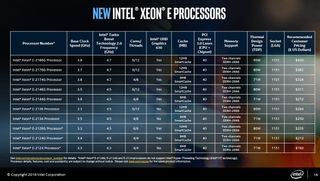Intel Launches Xeon E Processors for Workstations
Intel announced its new Xeon E processors for the low end of the workstation market. Intel targets the new processors, which come with up to six cores and 12 threads, for professional users, such as designers, content creators, and data scientists. Ultimately the new Xeon E lineup serves as a lower-cost and lower-performance variant of Intel’s Xeon W lineup.

Intel built the new processors with the same fundamental design as its Coffee Lake processors and are also available in SKUs that range from four cores and four threads up to six cores and 12 threads, but the Xeon E models support up to 40 PCIe Gen 3.0 lanes. Intel splits the lanes between 16 lanes that are exposed to the user and four DMI 3.0 lanes that connect to the C246 workstation-series chipset that provides an additional 24 usable lanes.
The processor comes outfitted with a dual-channel memory controller and supports up to 64GB of DDR4-2666 ECC memory. Intel’s desktop models don’t support ECC memory, which protects the data held in memory with an additional layer of parity, so this is one of the key differentiating features for the workstation market. The processors also support the staples we expect in workstation-class processors, such as Intel’s vPro, which is a suite of enterprise-class management, reliability, and security features. The Xeon E models that have a “G” modifier attached to the end of the product name, such as the Xeon E-2186G, come with an integrated UHD Graphics 630 engine. Intel also offers versions with the integrated UHD Graphics P360 engine that supports up to 64GB of video memory.
The processors come outfitted with up to 12MB of L3 cache and TDP ratings that span from 71W to 95W. As with all Intel processors, the TDP ratings are derived from the base clocks, which top out at 3.8 GHz for the flagship models. Turbo Boost frequencies stretch up to a maximum of 4.7 GHz, but that increased performance comes at the cost of more power consumption. For instance, the 80W SKUs reach up to 100W during Turbo Boost, and the 95W models can pull up to 130W.





Unlike Intel’s Xeon Scalable models, which use the enterprise LGA 4367 socket, the Xeon E models drop into the familiar LGA 1151 interface. The Xeon E processors also do not support multi-socket configurations, but they do support USB 3.1 Gen 2 (up to 10 Gb/s) and Thunderbolt 3.








Compared to the Xeon E3-1200 v6 processors, Intel claims the new processors offer up to 1.45X performance in services applications and up to 1.36X more performance in compute-intensive applications.
Overall, the Xeon E processors supplant the existing Xeon E3 family, which marks a change to Intel’s branding for the lower-end processors. Intel confirmed the processors are based on a 14nm architecture. Intel currently has 14nm, 14nm+, and 14nm++ processors on the market, but Intel isn’t sharing any details about the Xeon E’s specific process technology.
Stay on the Cutting Edge
Join the experts who read Tom's Hardware for the inside track on enthusiast PC tech news — and have for over 25 years. We'll send breaking news and in-depth reviews of CPUs, GPUs, AI, maker hardware and more straight to your inbox.
Intel says the processors are available now, and OEM systems from Dell, HP, and Lenovo are also slated for availability soon.
EDIT: Intel confirmed the Xeon E processors do not come with the mesh architecture.

Paul Alcorn is the Managing Editor: News and Emerging Tech for Tom's Hardware US. He also writes news and reviews on CPUs, storage, and enterprise hardware.
-
atomicWAR Reply21136164 said:14+++++++ ??
Yeah pretty much. Between performance gains or lack there of and much delay processes are exactly why I am sitting on my sandy bridge 6 core for a little while longer ;) -
bit_user Reply
Sorry, I'm not buying it. Just look at the specs. iGPU, no AVX-512, and compare the clock speeds and TDP numbers with desktop Coffee Lake.21135616 said:Intel built the new processors with the same fundamental design as its Xeon Scalable processors.
Because they are Coffee Lake, but without support for ECC memory disabled.21135616 said:The Xeon E processors are similar to Intel’s Coffee Lake desktop models
...that supports an additional 24 lanes.21135616 said:the Xeon E models feature a revamped architecture and support up to 40 PCIe Gen 3.0 lanes. Intel splits the lanes between 16 lanes connected directly to the processor, and an additional 24 lanes hang off the C426 workstation-series chipset
Fixed.
No, I think that slide was just tacked on to show noobs how cool they could be if they even went beyond the "new" E-series and stepped it up to W or some "precious metal" Xeons.21135616 said:The processors come with Intel’s Mesh Architecture
Most Popular

